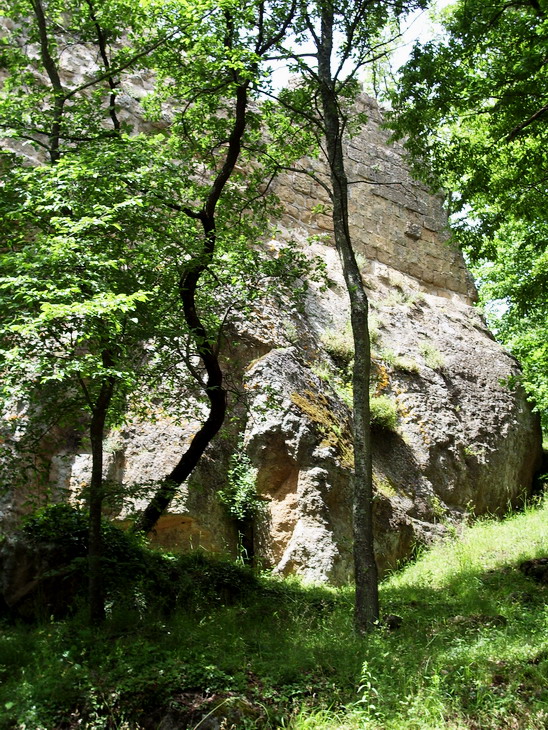Vitozza is an important rock settlement located in the municipality of Sorano. Its location is in the south-eastern part of the municipal area, a couple of kilometers north-west of the hamlet of San Quirico.
History
The ancient city of Vitozza was built in the Middle Ages, almost certainly at the end of the 11th century, around the castle built by the Aldobrandeschi family. The castle structure was built in the heart of a rock settlement which was probably already inhabited in the Etruscan-Roman era.
In the first half of the thirteenth century, the center temporarily passed first under the control of Orvieto and then of the Baschi family, who owned numerous properties in the eastern part of the province of Grosseto, before being taken over again by the Aldobrandeschi and included in the territory of the County of Sovana in 1274 , the year of the division of the family assets.
Between the end of the thirteenth century and the beginning of the fourteenth century, the place was conquered by the Sienese who incorporated it into the Republic of Siena and controlled it, despite numerous disputes, until the mid-fifteenth century. Subsequently, Vitozza became part of the Orsini County, within which it was of fundamental importance; however, later there was a progressive abandonment of the castle nucleus and its defensive structures for still unknown reasons, which subsequently caused a very long and inexorable decline.
Nonetheless, the rock settlement of Vitozza, despite seeing the population gradually migrate towards the nearby center of San Quirico of sixteenth-century origins, was inhabited until almost the entire eighteenth century. In 1783 the Lorraines took a census of the resident population; at the entrance to some caves there is a descriptive panel which also indicates the names of the people or families who lived there at the time of the aforementioned census.
The definitive abandonment of the caves took place precisely at the end of the eighteenth century.
Archaeological area
Vitozza in the Middle Ages featured a significantly fortified castle, at least two fortresses and religious buildings including a pieve and two churches which have decayed together with the rest of the town, as well as the characteristic rock settlement.
Rock settlement of Vitozza
The rock settlement of Vitozza is certainly the largest and most important in central Italy. It includes over two hundred caves, which were used as dwellings since medieval times, some of which were still populated in the eighteenth century when the Lorraines carried out the census of the inhabitants of the area.
The caves used for residential purposes extend along the paths that cross the wood that dominates the upper valley of the Lente river, going up to its source; some are quite close together, while others tend to be more isolated.
On the basis of their typology, caves can in fact be classified into four different types of reference:
A first group is characterized by caves with rectangular openings which are often arranged on several levels connected to each other by ladders and passages, with the houses located on the upper levels and the animal shelters to the lower ones.
A second group of caves has rectangular plants with structures intended to house animals.
A third type of cave was used for mixed uses: they are characterized by an arched opening, a culminating plant with a circular sector and more finishes. The circular part, for animal use, was equipped with a manger; the other rooms were probably used as homes.
A few dozen caves, called columbariums, based on the use to which they were intended. These were almost certainly built in Roman times and remained active throughout the Middle Ages, with the aim of being exploited for pigeon breeding, a very widespread practice in the Sorano area.
Rocche di Vitozza
The first castle is a fortification that takes the form of ruins, located along the path that crosses the entire rocky settlement.
You reach it after passing a dozen caves which, until the end of the eighteenth century, were used for residential purposes. The fortification is the first of the two fortresses that characterize the remains of the medieval castle of Vitozza.
The structure has thick tuff ashlar walls, which incorporated a door that opened along the access road. The remains of the fortress are visible from both sides of the path that branches off just before. On the northern side, the structure was bordered by a moat, now made invisible by the vegetation, which further protected the defensive structure ensuring greater safety.
The second castle is a fortified structure located along the path that leads to the columbaria (caves used for breeding birds) and the source of the river Lente; the fortification is, in fact, the second stronghold of Vitozza. The structure is situated on a hillock which rises to the right of the path and can be reached after passing another series of caves for residential use. The walls are articulated on two curtain walls which overall develop in an L shape, appearing covered in tufa ashlars, resting on a rocky base of the same material which constitutes the natural shoe base. Compared to the first fortress more remains are preserved.
La Chiesaccia
The ruins of a religious building from the Middle Ages, called La Chiesaccia, can be reached by turning right from the path coming from San Quirico, near the first fortress.
Near the church, the ruins of another fortified building which performed defensive functions are visible on the northern side of the plateau, as well as the remains of a gate which controlled access through the road parallel to the ridge.
The religious building must have had a rectangular plan and a single hall with a semicircular apse.



